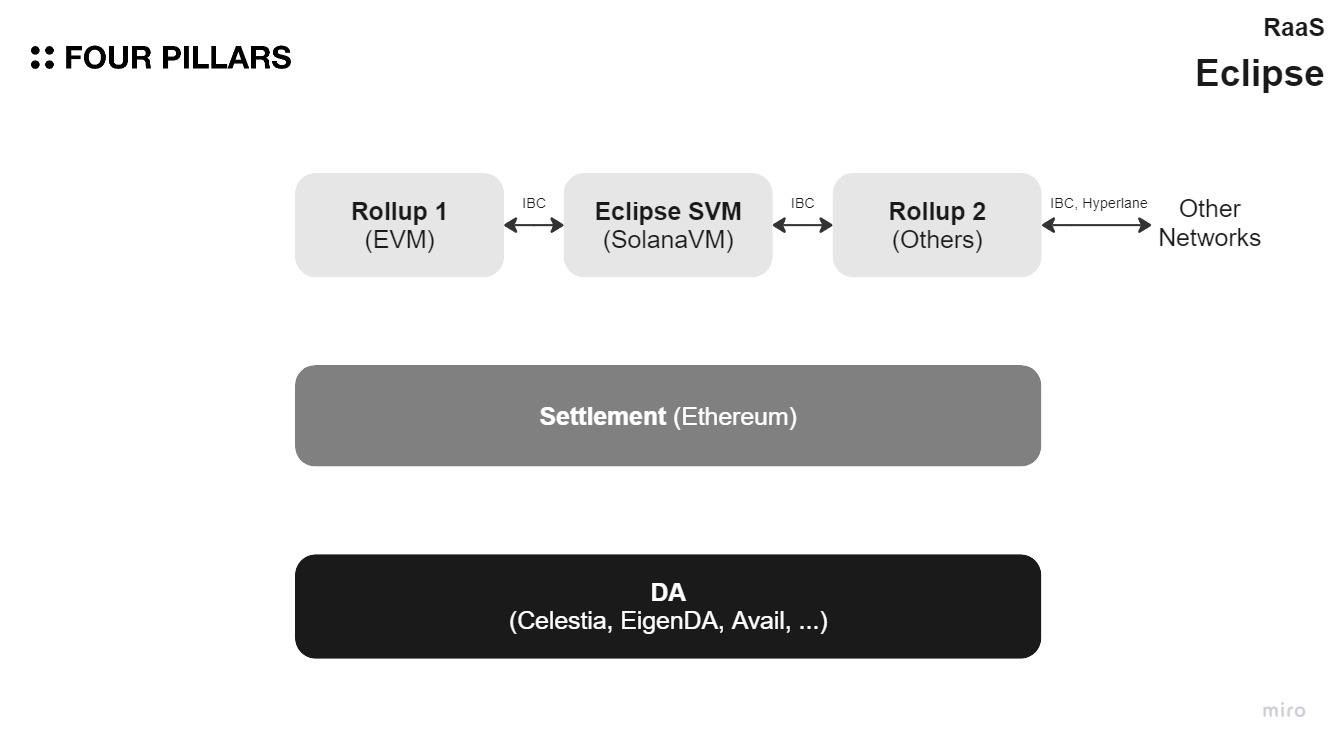Eclipse
Key Takeaways
- Eclipse is a customizable rollup framework using the Solana Virtual Machine.
- A significant advantage of Eclipse chains is that they allow for customization of the execution, DA layer, and various other elements.
- Eclipse mainnet is a general-purpose L2, combining various modular components, including SolanaVM as an execution layer, Ethereum as a settlement layer, and Celestia as a DA layer.
1. Overview

Eclipse is a customizable rollup framework using the Solana Virtual Machine. The rollups created with Eclipse offer a high degree of freedom for customization, presenting the advantage of utilizing various solutions for each modular element.
For example, Eclipse mainnet is a general-purpose L2, combining various modular components, including SolanaVM as an execution layer, Ethereum as a settlement layer, and Celestia as a DA layer.
2. Execution
Currently, Eclipse supports both EVM and SolanaVM, with plans to support a variety of execution environments, such as MoveVM, in the future. Both execution environments have well-established development tools and infrastructure, offering the advantage of using existing development tools, wallets, and explorers. Notably, the EVM supported by Eclipse provides parallel processing, reportedly showing speeds ten times faster than Optimism.
The transaction lifecycle in Eclipse Chains is as follows:
- Transaction Generation: When users create transactions, they are sent to the RPC node. The RPC node uses different APIs depending on the network; in the case of EVM, it uses the typical Ethereum JSON-RPC, while for SVM, it supports SVM JSON-RPC.
- Sequencing: The order of the above transactions is determined by the Sequencer, with both single sequencer and shared sequencer supported. There has been an announcement about building the related infrastructure in collaboration with Saga for the shared sequencer.
- Producing a Block: Once the order of transactions is determined, a commitment to this order is created, and the Executor of Eclipse Chains executes it to update the state.
3. Settlement
Eclipse uses Ethereum network for the settlement. Eclipse Chains submit the state root commitment to the Eclipse settlement layer, and verifiers can validate this:
- Optimistic Settlement: During the challenge period, verifiers can pull transaction data from the DA layer, re-execute it, and verify its validity by comparing the result with the state root commitment. If the two values do not match, a fraud proof can be generated and propagated, and the executor of the Eclipse chain that ran the disputed transaction is slashed. The entity creating fraud proofs is not yet decentralized.
- Zero-Knowledge Settlement: For Eclipse Chains that perform validity verification of transaction execution through zero-knowledge proofs, they generate a validity proof through the Eclipse zk-VM, and if the validity proof is proven by a verifier in the Eclipse settlement layer, the transaction is immediately finalized.
Currently, Eclipse only provides optimistic settlement, and in the future, they support verification through ZKP using RISC Zero.
4. Data Availability
Eclipse Chains submit transaction data for the created block to the DA Layer, and the verifier in the Eclipse settlement layer can participate in verification by receiving this data from the DA Layer. They plan to support Celestia, Eigen DA, and Avail as DA layers and will support other DA layers in the future upon request.
5. Interoperability
Eclipse collaborates with Hyperlane to deploy mailbox contracts on SVM and EVM rollup networks, enabling communication with other networks using the Hyperlane bridge. In addition, they support IBC for communication between Eclipse chains or interaction with other networks supporting IBC. Note that IBC is supported only for networks using SVM because the finality time needs to be short.
6. Customization
In addition to choosing a virtual machine suitable for the rollup network, Eclipse offers various customizations.
- Gas Fees: Rollup networks can collect gas fees corresponding to sequencer fees from users, and the gas fees can be set with various options such as free, fixed price, premium, etc. Developers can also choose which token to receive the gas fee in (e.g., ETH, SOL, USDC, Rollup native token).
- Compliance, Privacy: While it is permissionless by default, whitelisting can be carried out to allow only specific users to interact.
- MEV: By collaborating with the Skip Protocol, options such as extracting and redistributing MEV within the network can be implemented.
- Specialized Opcodes: Support can be given for custom system programs such as introducing a new elliptic curve, VRFs, etc.
7. Business Model
Eclipse has developed multiple rollup testnets only for the actual expense (at-cost) for initial projects. There is no public information regarding the future business model.
8. Use Cases
8.1 Cascade (w/ Injective)
Injective, one of the Cosmos app chains, is collaborating with Eclipse to create an SVM rollup called Cascade. They use SVM as the execution environment, the Eclipse settlement layer as the settlement layer, and Celestia as the DA layer. Going further, the Injective team plans to apply ICS (Interchain Security) to Cascade in the future, with two options: 1) Cascade's operator (currently Eclipse) can participate in the consensus of the Injective app chain, or 2) Validators of the Injective app chain can participate as a decentralized sequencer in Cascade.
9. Team
- Neel Somani (Founder)
- Vijay Chetty (CBO)
